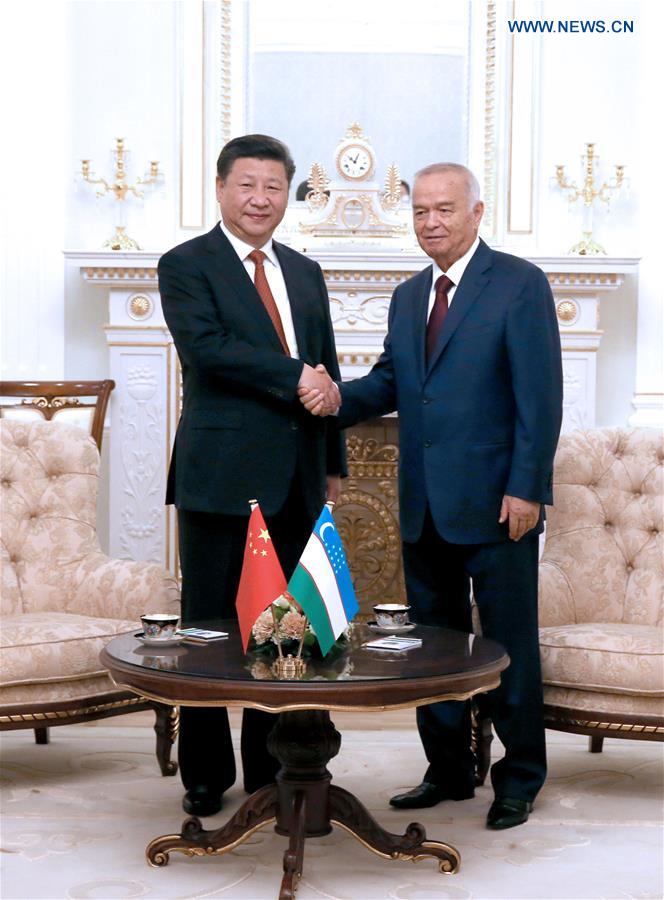Uzbekistan and China partnership in the new Silk Road
- By Mirzokhid Rakhimov
 0 Comment(s)
0 Comment(s) Print
Print E-mail China.org.cn, July 21, 2016
E-mail China.org.cn, July 21, 2016
|
|
| Chinese President Xi Jinping (L) holds talks with Uzbek President Islam Karimov in Tashkent, Uzbekistan, June 22, 2016. (Xinhua/Ma Zhancheng) |
Uzbekistan and other Central Asian republics consider the development of alternative regional transportation and communication arteries as important to their national and regional strategies. The various initiatives in this regard have resulted from the revival of the Great Silk Road and the development of new transportation links towards the east, west, south and north. Some priorities for the countries in the region include the development of transportation corridors to seaports and international markets as well as the construction of oil and gas pipelines. The countries are also striving to provide efficient functioning on these routes.
In the last two decades, a number of international transport and energy projects have been implemented. It should be noted that Uzbekistan was among the first to express its support for China's calls for the global Silk Road initiative "Belt and Road." China and Uzbekistan have already implemented several connectivity projects, including China-Kyrgyzstan-Uzbekistan highway.
It is well known that the Ferghana Valley is the most densely populated area in Central Asia and is administratively divided between Uzbekistan, Kyrgyzstan and Tajikistan. Over 10 million people – over a third of the country's population – live in the Namangan, Ferghana and Andijan regions of Uzbekistan. Against this background, it should be no surprise that the new railway project connecting Angren in the Tashkent region and Pap in the Namangan region is regarded as very important to Uzbekistan's national strategies of both internal and international connectivity.
The Angren-Pap line is only 123 kilometers long, but it crosses high mountainous areas, including areas with an elevation above 2000 meters, and is thus quite expensive. The cost of the Angren-Pap project was over $1.6 billion, and its construction has been made possible through a variety of sources. This includes more than $1 billion from Uzbekistan Temir Yollari (Uzbekistan Railways) and Uzbekistan's National Reconstruction and Development Fund. A loan of an additional $350 million was secured from China's EximBank, while the World Bank provided $195 million. Construction started in June 2013, and by 2016 more than ten new bridges and seven railway stations had been constructed as well as a 19.1 kilometer long tunnel under the Kamchik pass built by the China Railway Tunnel Group.
In June 2016, during President Xi's visits to Tashkent, Islam Karimov and Xi participated in the official opening of the Angren-Pap railway. According to Uzbekistan Temir Yollari, 600,000 passengers and about 4-6 million tons of goods could be delivered annually. While this railway will go a long way toward improving transportation inside Uzbekistan's borders, it is not sufficient, and there are considerable needs for the whole of the Ferghana Valley in terms of railroads and highways.
Moreover, the valley is important for the development of trade and communication links between China and Central Asia. A highway connecting Kashgar, Osh, and Andijan has been constructed, but the implementation of a railroad similarly connecting China, Kyrgyzstan and Uzbekistan has faced difficulties. The states have yet to formulate a common policy, and their positions diverge. Nevertheless, this project would connect well with the Angren-Pap railroad.
The development of strong transport corridors between China and Uzbekistan and China and Central Asia, including highways and potentially railroads, are part and parcel of the development of new routes linking the region to Asia and Europe. The synergies with existing and developing projects are potentially significant: for example, the improvement of connections between Central Asia and Afghanistan would contribute towards the future economic recovery of the latter.
Moreover, the development of transport communications between Central Asian countries and South and East Asia also are linked to this. These include connections such as Uzbekistan-Afghanistan-Iran, Uzbekistan-Afghanistan-Pakistan, and Uzbekistan-Turkmenistan-Iran-Oman-Qatar. Strong trans-regional cooperation will contribute to closer trade ties and closer economic and investment relations between Eurasia, the Middle East and the Asia-Pacific.
At the same time prospective plans for new transportation projects will depend on the balance of global, regional, interregional and national interests in the implementation of projects.
In conclusion, Uzbekistan and China have become active participants in various projects to promote economic cooperation between countries of Europe and Asia. The countries implemented several connectivity projects. The Angren-Pap rail project has been developed on the basis of Uzbek-China and multiple partnerships and will prove important for national connectivity as well as for increased international communication. A well-developed regional transport system in Central Asia will increase the potential for regional interconnectivity while providing a good opportunity to develop international networks and trade, including cultural and tourism.
Mirzokhid Rakhimov is a visiting Fulbright scholar at Johns Hopkins University. He is head of the Department of Contemporary History and International Relations of the Institute of History of the Academy of Science of Uzbekistan.
Opinion articles reflect the views of their authors, not necessarily those of China.org.cn.







Go to Forum >>0 Comment(s)